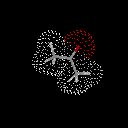|
|
||
 |
To determine a formula of a compound from its name you have to identify a compound as Ionic Compound Covalent compunds: write the element with a subscript that corresponds to the prefix. For example, carbon tetraiodide... Carbon is a nonmetal, and iodide is a nonmetal; therefore, carbon and iodide form a covalent compound. Thus, the covalent molecule nomenclature rules are used. Acids: add as many protons (H+) as needed to cancel the charge of the anion. For example, hydrochloric acid... The name has the word acid in it; therefore, it is an acid. Thus, the acid nomenclature rules are used. Example, phosphoric acid... The name has the word acid in it; therefore, it is an acid. Thus, the acid nomenclature rules are used.
Ionic
compounds can be more difficult. For example, iron (III) oxide... Iron is a metal and oxygen (oxide) is a nometal; therefore, iron(III) oxid is an ionic compound. Thus, the nomenclature rules for ionic compounds are used. The charges of the cations and the anions must be known to determine the formula of the compound. Step 1 determine the charge of the cation. Type I. Check the periodic table. Step 2 Determine the charge of the anion. Polyatomic anion. Remember the charge. Step 3 Combine ions so that the charges cancel. 3 (O2-) = -6 Fe2O3
Nomenclature |
|
|
|
|
|
